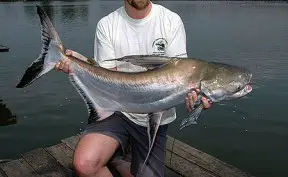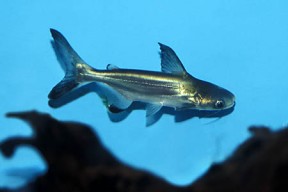Pangasius sanitwongsei
Paroon Shark
Classification
Pangasiidae
Distribution
Native to the lower Mekong river running through China, Thailand, Laos, Cambodia and Vietnam. It’s also found in the Chao Phraya river in Thailand. The majority of the fish seen in the aquatic trade come from commercial farms.
Habitat
It’s a pelagic species inhabiting main river channels and larger tributaries.
Maximum Standard Length
100″ (250cm) and up to 300 kg in weight! Although it rarely reaches this size in captivity, it’s easily capable of topping 48″ (120cm).
Aquarium SizeTop ↑
Totally unsuitable for home aquaria. It’s a very active open water species and tends to be skittish when kept in cramped conditions. This can lead to problems with the fish banging into the tank glass and items of decor, often resulting in injury. It’s beyond the limits of most public aquaria to house one of these long-term.
Maintenance
Not applicable.
Water Conditions
Temperature: 75 to 81°F (24 to 27°C)
pH: 6.5 to 7.5
Hardness: As the species' natural waters are subject to annual flooding, water parameters can vary considerably over the course of each year. General hardness is thus not critical, and anywhere in the range 2-30°H would be acceptable.
Diet
It’s omnivorous, but is primarily a meat-eater. In nature adults are known to be particularly fond of whole dog carcasses!
Behaviour and CompatibilityTop ↑
Not applicable.
Sexual Dimorphism
Mature females are rounder-bellied than males.
Reproduction
It’s a migratory species, moving upstream to spawn during the late spring and summer months. Obviously these conditions are virtually impossible to replicate in the home. Coupled with the massive size of sexually mature fish, it would seem that aquarium breeding is unlikely to be achieved. It’s being bred commercially for food in huge ponds on Far Eastern fish farms, though. Apparently the young fish we see in the hobby come from these same farms.
NotesTop ↑
In size and weight terms Pangasius sanitwongsei is second only to the giant Mekong catfish, Pangasianodon gigas in the family Pangasiidae, easily qualifying it as one of the largest freshwater fish species in the world.
Alarmingly it’s been exported for the trade in quite large numbers in recent years. It’s usually seen for sale as a cute silvery 2-3″ youngster, most often without adequate information regarding its long term care requirements and potential size. Unfortunately this means it makes it’s way into many a beginner’s community tank, as it’s undeniably attractive when small. The use of common names such as “paroon shark”, “hi-fin tiger shark” and “hi-fin” Pangasius don’t help the situation, being designed as they are to increase sales. There’s also a grossly disfigured ‘shortbody/balloon’ form that has been produced specifically for the aquarium trade. This grows to a significantly smaller size than the natural fish.
In reality though, the species should not be considered an aquarium subject at all. While P. sanitwongsei rarely reach its maximum size in captivity, it’s still easily capable of growing to several feet in length. The myth that fish will only grow to match the size of the tank it’s kept in is just that – a myth.
It’s also worth noting that it can live for around 20 years or more, which makes owning one a considerable commitment. Some aquarists also buy a young specimen with the intention of buying a bigger tank as it grows, without realising the true potential size of the species. Public aquaria are already inundated with far too many ‘cast offs’ from the hobby, and are unlikely to take a big one off your hands. No fellow hobbyists will have the facilities to do so, either.
It’s sad to think how many hundreds of these are doomed to a drastically shortened existence by the aquatic trade. Please don’t buy one if you see them on sale. This advice may appear a little extreme, but consider that nowhere can be found a report of a single hobbyist keeping a group of adult-sized specimens. Considering the thousands that are exported each year for the hobby, this would seem to tell its own story.





